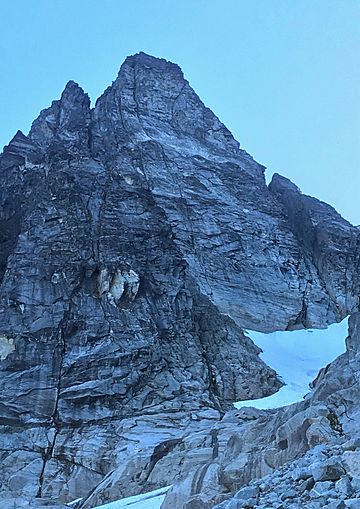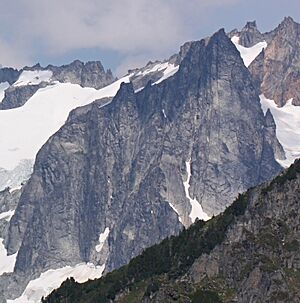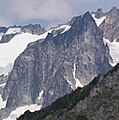Early Morning Spire facts for kids
Quick facts for kids Early Morning Spire |
|
|---|---|

Early Morning Spire
|
|
| Highest point | |
| Elevation | 8,200 ft (2,500 m) |
| Prominence | 240 ft (73 m) |
| Parent peak | Dorado Needle 8,440 ft |
| Geography | |
| Location | North Cascades National Park Skagit County, Washington |
| Parent range | North Cascades Cascade Range |
| Topo map | USGS Eldorado Peak |
| Geology | |
| Age of rock | Cretaceous |
| Type of rock | Orthogneiss |
| Climbing | |
| First ascent | 1971 by Richard Emerson and Tom Hornbein |
| Easiest route | Climbing class 4 |
Early Morning Spire is a tall mountain in Washington state. It stands about 8,200 feet (2,500 meters) high. You can find it in North Cascades National Park in Skagit County.
This peak is close to other famous mountains. It is near Dorado Needle and Eldorado Peak. You can often see Early Morning Spire from the North Cascades Highway. Look for it west of Marblemount, from a spot next to the Skagit River.
The first people to climb this mountain were Richard Emerson and Tom Hornbein in 1971. They climbed the Southwest Face. They had to spend a very cold night near the top. This chilly night is how the mountain got its unique name! Rain and melting snow from the mountain flow into Marble Creek. This creek then joins the Cascade River.
Contents
What's the Weather Like on Early Morning Spire?
Early Morning Spire is in a "marine west coast" climate zone. This means it gets a lot of moisture from the Pacific Ocean. Most weather systems start over the Pacific. They then travel northeast towards the Cascade Range.
When these weather systems reach the tall North Cascades mountains, they are pushed upwards. This causes them to drop their moisture as rain or snow. This process is called Orographic lift. Because of this, the western side of the North Cascades gets a lot of rain and snow. Winter months are especially snowy.
During winter, the weather is often cloudy. But in summer, high-pressure systems over the Pacific Ocean become stronger. This often leads to clear skies and sunny weather.
How Was Early Morning Spire Formed?
The North Cascades mountains have a very rugged look. They feature sharp peaks, spires, and deep valleys. These amazing shapes were created by geological events over millions of years. These events caused big changes in the land and its height.
The Cascade Range began forming a long time ago. This was during the late Eocene Epoch. The North American Plate was slowly moving over the Pacific Plate. This movement caused many volcanoes to erupt. Also, small pieces of land called terranes joined together. This helped create the North Cascades about 50 million years ago.

About two million years ago, during the Pleistocene period, glaciers played a big role. Huge sheets of ice moved across the land, carving out the valleys. They moved forward and then melted back many times. You can still see a small glacier on the southeast side of Early Morning Spire. The Marble Creek Glacier is also nearby to the north.
The valleys in this area have a U-shape. This shape is a clear sign that glaciers once moved through them. The lifting of the land (called uplift) and cracks in the Earth's crust (called faulting) also helped. These forces, along with glaciers, created the tall peaks and deep valleys we see today.
Climbing Routes on Early Morning Spire
People who enjoy climbing can find several routes on Early Morning Spire. These routes offer different levels of challenge.
- Southwest Face - This route is rated class 5.8.
- Southeast Face - This route is rated class 5.7.
- North Route - This route is rated class 4.
You can see an aerial photo of Early Morning Spire here: PBase
Images for kids





